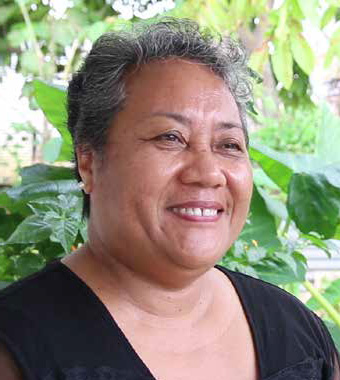 “The nutritional value of breadfruit is undisputed and its economic development is still yet to be realized. Our challenge in Tonga is for us to find the market opportunity that this crop offers so that it may assist the livelihood of Tongans.”
“The nutritional value of breadfruit is undisputed and its economic development is still yet to be realized. Our challenge in Tonga is for us to find the market opportunity that this crop offers so that it may assist the livelihood of Tongans.”
Minoru Nishi, Nishi Trading and Nishi Foundation, Tonga
There are many reasons for Pacific farmers to get involved in producing breadfruit: it is highly nutritious; it can be used as an import substitute for wheat, rice and potatoes; there are untapped export markets; it is natural disaster and climate change resilient; and there is an expanding body of knowledge on growing, agro-processing and end-product development which farmers can now access.
While farmer organisations have been quick to identify the benefits of breadfruit, governments and donors have generally been slower to see the importance. So, after developing a regional breadfruit programme, the farmer organisations found themselves unable to source funding for its implementation. At the Pacific Breadfruit Roundtable, held in Tonga in 2016, farmer organisations therefore collectively decided that breadfruit was too important to be ignored and that they couldn’t wait for
governments and donors to come to the table. They therefore coordinated their separate work plans and resources across the region to progress the breadfruit programme on their own.
The MTCP2 programme has been able to fund a considerable amount of this independent, yet coordinated work relating to breadfruit. As a result, breadfruit is becoming more integrated into farming systems in more concerted ways and is becoming lodged in the minds of Pacific farmers. The programme has supported some really exciting national and local activities, which were then strengthened by regional learning exchanges.
In Fiji, Nature’s Way Cooperative already had its own breadfruit programme, but with further funding and the opportunity to draw on and learn from other farmer organisations in the network, they have had some very tangible impacts.
In Tonga, farmer organisations have been doing some great work, after an initial learning exchange to Fiji opened their minds to the potential of this indigenous Pacific tree.
 “Our farmers learnt that breadfruit can be planted in orchards instead of how we traditionally plant them, anywhere and everywhere. From Fiji they were taught the technical skills required for orchard cropping and since they returned, those farmers have put their newfound knowledge to practise. Further, they have trained other farmers as well on this knowledge too.”
“Our farmers learnt that breadfruit can be planted in orchards instead of how we traditionally plant them, anywhere and everywhere. From Fiji they were taught the technical skills required for orchard cropping and since they returned, those farmers have put their newfound knowledge to practise. Further, they have trained other farmers as well on this knowledge too.”
Sinai Tuitahi, Chief Executive Officer, GroFed Tonga
The three major famer organisations from Tonga that are engaging in the MTCP2 programme came together to coordinate their activities around breadfruit. MORDI Tonga is concentrating on various technical aspects of breadfruit propagation and growth, Nishi Trading is focusing on breadfruit processing, while GroFed is leading the way with orchard establishment.
MORDI’s work has involved construction of demonstration nurseries, collecting breadfruit seedlings, training on breadfruit propagation, conducting a breadfruit baseline survey, breadfruit nursery monitoring and exploring new ways of cooking breadfruit.
Nishi Trading has been conducting tests on drying breadfruit for subsequent processing into snacks and flour, and is now taking their results out to the community for feedback. They also have their own breadfruit planting program, where breadfruit is intercropped with a range of other cash crops, such as: coffee; lettuce; taro; sweet yams; pineapple; plantain; sandalwood; peanuts; cow peas; moringa; cassava and maize.
In 2017, both MORDI Tonga and Nishi Trading, in partnership with the Government of Tonga, secured Japanese aid for a US$3million, five year Breadfruit and Nutrition project through the JICA Partnership Program. This project builds on the breadfruit work already carried out through MTCP2.
Meanwhile GroFed, as well as establishing single-crop breadfruit orchards, is working on establishing SMART farms where breadfruit is intercropped with a variety of other plants, such as: coconuts; sandalwood; vanilla; kava; pele (spinach); and papaya. These SMART farms meet the daily domestic needs of the grower and his family; provide for annual family and church obligations; provide for long term needs, such as building a new house or university education fees; as well as providing food security and helping to protect the grower against the impacts of climate change.
And back in Fiji, the Tutu Rural Training Centre has developed a thriving cottage industry around breadfruit flour and breadfruit chips, which is detailed in a story in the Fiji section. In addition, Tutu was nominated by the other farmer organisations to lead the implementation of the Pacific breadfruit programme, coordinating the six other collaborating farmer organisations in the region.
This level of commitment to a project that requires them to make significant allocations of their own resources to achieve outcomes is unprecedented for farmer organisations in the region. It has also required a level of regional cooperation between farmer organisations that would not have been possible before the MTCP2 programme. A series of inter-regional technical partnerships between the farmer organisations working on breadfruit has ensured that knowledge and learning outcomes are shared, and reduces the likelihood of unnecessary replication of activities.
For many Pacific Islanders breadfruit is still a food of last resort, often called ‘cyclone food’ it is what you eat when nothing else is available. That attitude is starting to change however, and breadfruit is starting to become “cool”. A large portion of this changing attitude is the result of the work being done by farmer organisations across the region and the subsequent sharing of this information. Once a forgotten tree in terms of investment, all the signs now point to breadfruit having a big future!
